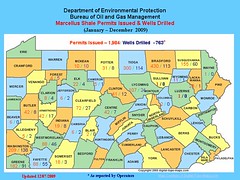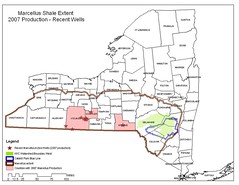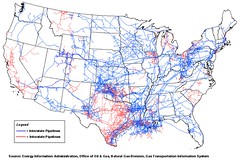STEVE MOCAR
timesleader.com
Thurs., May 20, 2010
The head of a state environmental regulatory bureau said the public can help protect Pennsylvania waterways from pollution related to natural gas drilling in the Marcellus Shale by contacting legislators and a review board in support of tough new proposed regulations.
Scott R. Perry, director of the state Department of Environmental Protection’s Bureau of Oil and Gas Management, said last week that the oil and gas industry is “dead-set against these regulations on total dissolved solids in flowback fracking water. We’re going to have a huge fight with the Independent Regulatory Review Commission,” he said.
The hydraulic fracturing process (fracking) used to release natural gas from the shale, requires injecting about 5 million gallons of water into the ground per well. About 12 percent of that water, which contains trace chemicals and high concentrations of dissolved solids such as salt, flows back and must be disposed.
DEP Secretary John Hanger said in a press release that the new rules will ensure that the total dissolved solids, or TDS, in drilling wastewater do not pollute drinking water supplies, damage industrial equipment or endanger delicate aquatic life.
“Drilling wastewater contains TDS levels that are thousands of times more harmful to aquatic life than discharges from other industries. Without imposing limits on this pollution, treatment costs for this wastewater are passed along to downstream industries and municipal ratepayers,” Hanger said. “All other industries in Pennsylvania are responsible for the waste they generate, and the drilling industry should be no exception.”
Putting TDS in perspective:
In a phone interview, Hanger said the TDS concentration in discharges from landfills is about 2,000 miligrams-per-liter (mg/l). In coal mine discharges, it’s about 20,000 to 30,000 mg/l. In Marcellus Shale drilling discharges, it’s about 300,000 mg/l.
Under the new regulations, wastewater discharges from new and expanded facilities must meet a concentration threshold of 2,000 mg/l and discharges from drilling operations cannot exceed 500 mg/l.
The state Environmental Quality Board on Monday approved the regulations. Next, the rules will go to the Environmental Resources and Energy committees in the state House and Senate, as well as to the Independent Regulatory Review Commission for a 30-day review period.
The new rule was “thoroughly vetted and scrutinized” and amended in response to industry concerns, Hanger said.
Still, when speaking last week with members of the public at Lake-Lehman High School after a presentation on DEP’s role in regulating natural gas drilling, Perry said he could foresee “legislative action to intervene in trying to disapprove these regulations. Part of the regulatory process allows the House and Senate to pass resolutions disapproving the law.”
The industry likely would oppose the regulations because outfitting treatment facilities with equipment capable of lowering the concentrations of TDS would be expensive, as would be alternative disposal methods.
Perry said the public needs to step up in support of the regulations to protect the environment.
“Legislators and the Independent Regulatory Review Commission need to hear from more people than just industry representatives,” he said.
DEMAND ACCOUNTABILITY!



















No comments:
Post a Comment